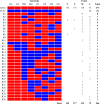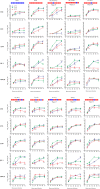Tissue tropisms opt for transmissible reassortants during avian and swine influenza A virus co-infection in swine
- PMID: 30507946
- PMCID: PMC6292640
- DOI: 10.1371/journal.ppat.1007417
Tissue tropisms opt for transmissible reassortants during avian and swine influenza A virus co-infection in swine
Abstract
Genetic reassortment between influenza A viruses (IAVs) facilitate emergence of pandemic strains, and swine are proposed as a "mixing vessel" for generating reassortants of avian and mammalian IAVs that could be of risk to mammals, including humans. However, how a transmissible reassortant emerges in swine are not well understood. Genomic analyses of 571 isolates recovered from nasal wash samples and respiratory tract tissues of a group of co-housed pigs (influenza-seronegative, avian H1N1 IAV-infected, and swine H3N2 IAV-infected pigs) identified 30 distinct genotypes of reassortants. Viruses recovered from lower respiratory tract tissues had the largest genomic diversity, and those recovered from turbinates and nasal wash fluids had the least. Reassortants from lower respiratory tracts had the largest variations in growth kinetics in respiratory tract epithelial cells, and the cold temperature in swine nasal cells seemed to select the type of reassortant viruses shed by the pigs. One reassortant in nasal wash samples was consistently identified in upper, middle, and lower respiratory tract tissues, and it was confirmed to be transmitted efficiently between pigs. Study findings suggest that, during mixed infections of avian and swine IAVs, genetic reassortments are likely to occur in the lower respiratory track, and tissue tropism is an important factor selecting for a transmissible reassortant.
Conflict of interest statement
The authors have declared that no competing interests exist.
Figures





Similar articles
-
Pathogenicity and transmissibility of novel reassortant H3N2 influenza viruses with 2009 pandemic H1N1 genes in pigs.J Virol. 2015 Mar;89(5):2831-41. doi: 10.1128/JVI.03355-14. Epub 2014 Dec 24. J Virol. 2015. PMID: 25540372 Free PMC article.
-
Zoonotic Risk, Pathogenesis, and Transmission of Avian-Origin H3N2 Canine Influenza Virus.J Virol. 2017 Oct 13;91(21):e00637-17. doi: 10.1128/JVI.00637-17. Print 2017 Nov 1. J Virol. 2017. PMID: 28814512 Free PMC article.
-
Seasonal H3N2 and 2009 Pandemic H1N1 Influenza A Viruses Reassort Efficiently but Produce Attenuated Progeny.J Virol. 2017 Aug 10;91(17):e00830-17. doi: 10.1128/JVI.00830-17. Print 2017 Sep 1. J Virol. 2017. PMID: 28637755 Free PMC article.
-
[Swine influenza virus: evolution mechanism and epidemic characterization--a review].Wei Sheng Wu Xue Bao. 2009 Sep;49(9):1138-45. Wei Sheng Wu Xue Bao. 2009. PMID: 20030049 Review. Chinese.
-
Isolation and genetic characterization of avian-like H1N1 and novel ressortant H1N2 influenza viruses from pigs in China.Biochem Biophys Res Commun. 2009 Aug 21;386(2):278-83. doi: 10.1016/j.bbrc.2009.05.056. Epub 2009 May 19. Biochem Biophys Res Commun. 2009. PMID: 19460353 Review.
Cited by
-
Tissue Tropisms of Avian Influenza A Viruses Affect Their Spillovers from Wild Birds to Pigs.J Virol. 2020 Nov 23;94(24):e00847-20. doi: 10.1128/JVI.00847-20. Print 2020 Nov 23. J Virol. 2020. PMID: 32967956 Free PMC article.
-
Naturally occurring influenza reassortment in pigs facilitates the emergence of intrahost virus subpopulations with distinct genotypes and replicative fitness.mBio. 2025 Jan 8;16(1):e0192424. doi: 10.1128/mbio.01924-24. Epub 2024 Nov 29. mBio. 2025. PMID: 39611844 Free PMC article.
-
Quo vadis? Central Rules of Pathogen and Disease Tropism.Front Cell Infect Microbiol. 2021 Feb 25;11:640987. doi: 10.3389/fcimb.2021.640987. eCollection 2021. Front Cell Infect Microbiol. 2021. PMID: 33718287 Free PMC article. Review.
-
Vaccination decreases the risk of influenza A virus reassortment but not genetic variation in pigs.Elife. 2022 Sep 2;11:e78618. doi: 10.7554/eLife.78618. Elife. 2022. PMID: 36052992 Free PMC article.
-
Applications and Considerations of Artificial Intelligence in Veterinary Sciences: A Narrative Review.Vet Med Sci. 2025 May;11(3):e70315. doi: 10.1002/vms3.70315. Vet Med Sci. 2025. PMID: 40173266 Free PMC article. Review.
References
-
- Tong S, Li Y, Rivailler P, Conrardy C, Castillo DA, Chen LM, et al. A distinct lineage of influenza A virus from bats. Proc Natl Acad Sci U S A. 2012;109(11):4269–74. 10.1073/pnas.1116200109 ; PubMed Central PMCID: PMCPMC3306675. - DOI - PMC - PubMed
-
- Tong S, Zhu X, Li Y, Shi M, Zhang J, Bourgeois M, et al. New world bats harbor diverse influenza A viruses. PLoS Pathog. 2013;9(10):e1003657 10.1371/journal.ppat.1003657 ; PubMed Central PMCID: PMCPMC3794996. - DOI - PMC - PubMed
-
- Olsen B, Munster VJ, Wallensten A, Waldenstrom J, Osterhaus AD, Fouchier RA. Global patterns of influenza a virus in wild birds. Science. 2006;312(5772):384–8. 10.1126/science.1122438 . - DOI - PubMed
Publication types
MeSH terms
Grants and funding
LinkOut - more resources
Full Text Sources

